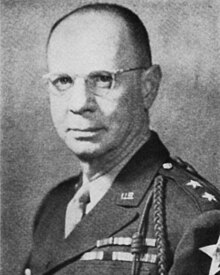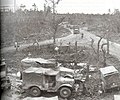Battle of Wahlerscheid
| date | December 13, 1944 to December 26, 1944 |
|---|---|
| place | Forsthaus Wahlerscheid, Eifel , Germany |
| output | first tactical victory for the Americans, then retreat |
| Parties to the conflict | |
|---|---|
| Commander | |
| losses | |
|
unknown |
unknown |
Prelude
Kesternich - Wahlerscheid
German attack
Losheimergraben - Clervaux - Stößer - Greif
Allied defense and counter-attack
Elsenborn ridge - St. Vith - Bastogne - Bure
German counterattack
base plate - north wind
The battle of Wahlerscheid took place at an important intersection between Monschau and Schleiden near a forester's house. The Westwall and with it the former German border security towards Belgium ran through this heavily forested area . At the beginning of December 1944, the V. US Corps deployed the 2nd Infantry Division in the Belgian villages of Rocherath-Krinkelt near the Elsenborn ridge, about 25 km south of the Hürtgen Forest , in order to prepare for the further attack to the west. The battle went down in American military history as the Battle of Heartbreak Crossroads , as the attacking American troops had to retreat after the loss-making conquest of this section of land due to the German Ardennes offensive . To the east of the western wall there was a well-developed railway network that led to the Rur dams and dams . In order to prevent the Germans from destroying these reservoirs in order to stop the American attack on Germany, the Eifel should be occupied quickly. The intersection at Wahlerscheid served as the planned starting point. From there, along the roads and paths, a rapid advance to the northwest was to be made. The Americans failed to take the intersection during the first two days of the battle. They suffered considerable losses in the process. On the third day, an American infantry platoon seeped through the heavily fortified German defense line, which succeeded in penetrating the German trench and position system and occupying the intersection. With the start of the German Ardennes offensive on December 16, 1944, the Americans threatened to be trapped and isolated at Wahlerscheid and received the order to retreat to Krinkelt - Rocherath.
The German preparations
In order to defend the imperial borders in view of the imminent attack by the Allies on Germany, the LXVII. Corps deployed under Lieutenant General Otto Hitzfeld along the western wall between Vossenack and Udenbreth . For this purpose, Hitzfeld ordered the 272nd and 277th Volksgrenadierdivision to the German-Belgian border. Grenadier regiments 989, 990 and 991 (277th Volksgrenadierdivision) were supposed to defend along the line Höfen - Alzen - Monschau - Wahlerscheid - Udenbreth. Before the American attack, the Germans had sufficient time to further strengthen the defenses of the western wall and to establish themselves in the position systems. Barbed wire barriers and wire barriers were laid, trenches reinforced, mines buried and the existing bunkers occupied. These preparations were to be supported by the deployment of the 326th Volksgrenadierdivision, whose relocation to the southern Eifel was delayed.
The American preparations
At the beginning of December 1944, the 99th Infantry Division and the 2nd Infantry Division were deployed side by side along the German-Belgian border near Elsenborn .
At Krinkelt - Rocherath there was a gap in defense between the two divisions. There was a danger that the Germans could use this gap for a counterattack in order to advance to the west. General Leonard T. Gerow therefore ordered the 9th Infantry Regiment to attack the area around Krinkelt-Rocherath on December 13th. The area there was characterized by dense forests and short lines of sight up to the Wahlerscheid further north. This also did not allow the Americans to determine the real strength of the German defenses. The 9th Infantry Regiment was supported by heavy artillery, a tank battalion and two tank destroyer battalions in its impending attack.
The attack
In the early morning hours of December 13th, the Americans began their attack from Rocherath heading north through the dense forest in heavy snowfall, cold and limited visibility. The road between Krinkelt - Rocherath and the intersection at the Forsthaus Wahlerscheid, which still exists today, was the axis of attack. At this intersection there were over 30 German bunkers and fortified positions. The forest there had been extensively cleared in advance by the Germans in order to have a clear field of fire for machine guns and artillery. In addition, the country road and paths in the woods were mined. The American attack initially proceeded according to plan and without major resistance. However, since the advance was carried out without prior artillery fire, the 9th Infantry Regiment encountered particularly fierce resistance, especially at the intersection and at the Forsthaus Wahlerscheid. The 991 grenadier regiment defended the intersection very effectively from the bunkers and positions. The Americans failed to break into the German defensive positions. On December 13 and 14, the Americans failed to break through the German lines of defense. Although the 9th Infantry Regiment used precise artillery fire against the German positions, the attacking infantrymen were repeatedly exposed to heavy gunfire. Progress was also made difficult by the snow and the massive barbed wire obstacles. Attempts to remove these obstacles with explosive charges often failed because the detonators had become damp. On December 14th, an American troop seeped through a small section of the barbed wire and bombarded German patrols for several hours. However, he had to retreat at nightfall. On December 15, another troop managed to move through the obstacles to the German bunkers. The commander of the 2nd Battalion, 9th Infantry Regiment then ordered two of his companies to attack through the narrow gap in the line of defense. As a result, several bunkers fell into the hands of the Americans until, on December 16, despite tough resistance, they finally managed to occupy the intersection at the Forsthaus Wahlerscheid.
Threatened inclusion by the Battle of the Bulge
After the Americans had succeeded in taking the junction at Wahlerscheid, massive artillery fire by the Wehrmacht began on American positions on December 16, 1944, further south along the German - Luxembourg border. Army Group B attacked with three armies to occupy the area between Brussels and Antwerp. Completely surprised by the Ardennes offensive , the Americans had to retreat hastily. Within a few days, the Wehrmacht managed to advance into the rear of the American front. This threatened the 2nd Infantry Division at Krinkelt, Rocherath and Wahlerscheid with the confinement and separation from the rest of the American front. To prevent this, the 2nd Infantry Division and the 99th Infantry Division received the order on the evening of December 16, 1944 to stop the attack on the Hürtgenwald region.
American withdrawal to Elsenborn
On December 17, 1944, General Robertson was able to gather his troops in the area around Rocherath and Krinkelt. The Americans had had to leave their positions at the crossroads, which had been occupied after hard fighting, and retreated to the west. The term “Heartbreak Crossroads” quickly established itself among the American soldiers deployed - because it was with a heavy heart that this important crossroads had to be left to the enemy despite all the losses that went with it. The Americans withdrew to the contour line at Elsenborn and held these positions during the German Ardennes offensive. The fact that they had not destroyed the bunkers in the woods of Wahlerscheid during their retreat turned out to be a mistake in February 1945. During the new American offensive towards Hürtgenwald in the spring of 1945, these positions had to be fought hard again with the Wehrmacht.
gallery
literature
- Edward G. Miller: A Dark and Bloody Ground: The Hürtgen Forest and the Roer River Dams, 1944-1945. Texas A&M University Press, 1995, ISBN 1-58544-258-5 .
- Allyn R. Vannoy; Jay Karamales: Against the Panzers. United States Infantry versus German Tanks, 1944-1945. McFarland & Company, Inc. Publishers 2006, ISBN 0-7864-2612-8 .
- Hans Wijers: Battle of the Bulge, Vol. 1: The Losheim Gap / Holding the Line. Stackpole Books, Mechanicsburg, PA, 2009, ISBN 978-0-8117-3592-6 .
- William CC Cavanagh: The Battle East of Elsenborn and the Twin Villages. Pen and Sword Books, 2012.
Individual evidence
- ^ Hans Wijers: Battle of the Bulge, Vol. 1: The Losheim Gap / Holding the Line. Stackpole Books, Mechanicsburg, PA, 2009, ISBN 978-0-8117-3592-6 , pp. 9ff.
- ^ Story of the 2nd Infantry Division . Stars and Strips. Retrieved July 4, 2015.
- ^ Edward G. Miller: A Dark and Bloody Ground: The Hürtgen Forest and the Roer River Dams, 1944-1945. Texas A&M University Press, 1995, ISBN 1-58544-258-5 , pp. 188.





